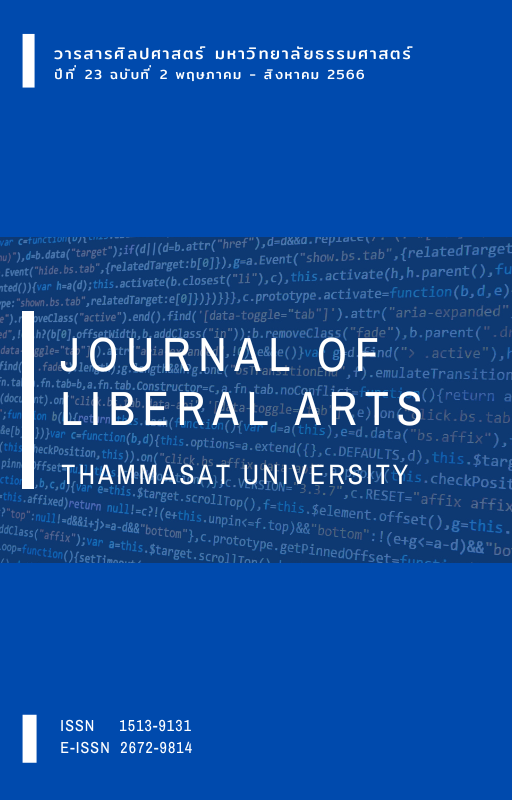การสร้างความมั่นคงและยั่งยืนให้กับประชาธิปไตยในอินโดนีเซีย : ตัวแสดง สถาบันทางการเมือง และความสัมพันธ์ระหว่างพลเรือน-ทหาร
Main Article Content
บทคัดย่อ
บทความวิจัยนี้ศึกษากระบวนการสร้างความมั่นคงและยั่งยืนให้กับประชาธิปไตยในประเทศอินโดนีเซีย โดยเน้นศึกษาปัจจัยหรือเงื่อนไขที่นำไปสู่กระบวนการดังกล่าว นอกจากนี้ยังศึกษาบทบาทและปฏิสัมพันธ์ระหว่างตัวแสดงต่าง ๆ ในกระบวนการดังกล่าว และศึกษาว่าการที่พลเรือนเข้ามามีบทบาทควบคุมกองทัพส่งผลอย่างไรต่อประชาธิปไตยในอินโดนีเซีย งานวิจัยนี้เน้นวิจัยเอกสารเป็นหลัก ผลการศึกษาสรุปว่าปัจจัยที่นำไปสู่ความมั่นคงและตั้งมั่นของประชาธิปไตยในอินโดนีเซียได้แก่ 1) การปฏิรูปกฎหมายและแก้ไขรัฐธรรมนูญปี 1945 2) การปฏิรูปกองทัพ 3) บทบาทของภาคประชาสังคม อินโดนีเซียได้ผ่านนิยาม “ประชาธิปไตยตั้งมั่น” ขั้นต่ำคือ อินโดนีเซียจะไม่หวนกลับไปเป็นการปกครองแบบเผด็จการอำนาจนิยมอีก
Downloads
Article Details

อนุญาตภายใต้เงื่อนไข Creative Commons Attribution-NonCommercial-NoDerivatives 4.0 International License.
เอกสารอ้างอิง
วิทยา สุจริตธนารักษ์. (2542). การพัฒนาเศรษฐกิจและการเมืองอินโดนีเซีย. โครงการจัดพิมพ์คบไฟ.
Abootalebi, A. R. (2000). Islam and democracy: State-soceity relation in developing countries 1980-1994. Garland.
Abdulbaki, L. (2008). Democratisation in Indonesia: From transition to consolidation. Asian Journal of Political Science, 16(2), 151-172.
Aminuddin, M. F. (2016). Electoral system and party dimension assessment in democratic Indonesia. Jurnal Ilmu Sosial dan Ilmu Politik, 20(1), 1-15.
Ananta, A., Arifin, Evi N. A., & Suryadinata, L. (2005). Emerging democracy in Indonesia. Institute of Southeast Asian Studies.
Aspinall, E., & Sukmajati, M. (Eds.). (2016). Electoral dynamics in Indonesia: Money politics, patronage and clientelism at the grassroots. NUS Press.
Bourchier, D. (2000). Habibie’s interregnum: Reformasi, elections, regionalism and the struggle for power. In C. Manning & Van P. Diermen (Eds.), Indonesia in transition: Social aspects of reformasi and crisis (pp. 15-38). Institute of Southeast Asian Studies.
Bünte, M., & Ufen, A. (2009). The new order and its legacy: Reflections on democratization in Indonesia. In M. Bünte & A. Ufen (Eds.), Democratization in post-suharto Indonesia (pp. 3-29). Routledge.
Dagg, C. J. (2007). The 2004 elections in Indonesia: Political reform and democratisation. Asia Pacific Viewpoint, 48(1), 47-59.
Diamond, L. (2003). Can the whole world become democratic? democracy, development, and international policies, Paper (No 03-05), Center for the Study of Democracy, University of California, Irvine.
Eddyono, L. W. (2018). The constitutional court and consolidation of democracy in Indonesia. Jurnal Konstitusi, 15(1), 1-26.
Elson, R. E. (2009). Another look at the Jakarta charter controversy 1945. Indonesia, 88, 105-130.
Feith, H. (2006). The decline of constitutional democracy in Indonesia. Equinox Publishing.
Gungwu, W. (2009). Introduction. In T. Abdullah (Ed.). Indonesia: Towards democracy (pp. xiii-xxi). Institute of Southeast Asian Studies.
Harijanti, S. D., & Lindsey, T. (2006). Indonesia: General elections test the amended constitution and the new constitutional court. International Journal of Constitutional Law, 4, 138-150.
Heryanto, A. (2014). Identity and pleasure: The politics of Indonesian screen culture. NUS Press.
Hill, D. T. (2005). The internet in Indonesia’s new democracy. Routledge.
Hill, D. T., & Sen, K. (2011). Politics and the media in twenty-first century Indonesia: decade of democracy. Routledge.
Huntington, S., & Nelson, J. M. (1976). No easy ChoiceL political participation in developing countries. Harvard University Press.
Indrayana, D. (2008). Indonesian constitutional reform 1999-2002: An evaluation of constitution-making in transition. KOMPAS Book Publishing.
Indonesia: Freedom in the World 2022. (2022). Freedom house. https://freedomhouse.org/country/indonesia/freedom-world/2022
King, D. Y. (2003). Half-hearted reform: Electoral institutions and the struggle for democracy in Indonesia. Praeger.
Kusmayati, A. (1994). Democracy in Indonesia [Master’s Thesis]. Naval Postgraduate School.
Liddle, R. W., & Mujani, S. (2006). Indonesia in 2005: A new multiparty presidential democracy. Asian Survey, 46(1), 132-139.
Lindsey, T. (2002). Indonesian constitutional reform: Muddling towards democracy. Singapore Journal of International & Comparative Law, 6, 244-301.
Linz, J., & Stepan, A. (1996). Toward consolidated democracies. Journal of Democracy, 7(2), 14-33.
Lipset, S. M. (1994). The social requisites of democracy revisited. American Sociological Review, 59(1), 1-22.
Mietzner, M. (2009). Indonesia’s 2009 elections: Populism, dynasties and the consolidation of the party system. Lowy Institute for International Policy.
Mietzner, M. (2013). Money, power, and ideology: Political parties in post-authoritarian Indonesia. NUS Press.
Mietzner, M. (2014, April 27). Jokowi: Rise of a polite populist. Inside Indonesia. https://www.insideindonesia.org/editions/elections-2014/jokowi-rise-of-a-polite-populist
Mujani, S., Liddle, R., William, R. L., & Ambardi, K. (2012). Kuasa rakyat: Analisis tentang perilaku memilih dalam pemilihan legislatif dan presiden Indonesia pasca-orde baru [People power: An analysis of voting behaviour in legislative and presidential elections in post-new order Indonesia’s legislative and presidential elections]. Mizan.
National Democratic Institute for International Affairs. (1999). The 1999 presidential election and post-election developments in Indonesia: A post-election assessment report. https://www.ndi.org/node/21592
National Democratic Institute for International Affairs. (2000). Indonesia’s road to constitutional reform: The 2000 MPR annual session. https://www.ndi.org/sites/default/files/1077_id_constireform_5.pdf
National Democratic Institute for International Affairs. (2001). Indonesia’s change of president and prospects for constitutional reform. https://www.ndi.org/sites/default/files/1319_id_presconstref102001_5.pdf
National Democratic Institute for International Affairs. (2002). The fundamental changes that nobody noticed: The MPR annual session, November 2001. https://www.ndi.org/sites/default/files/1378_id_gov_112002_5.pdf
National Democratic Institute for International Affairs. (2004). Advancing democracy in Indonesia: The second democratic legislative elections since the transition. https://www.ndi.org/sites/default/files/1728_id_legelections_063004_5.pdf
Nyman, M. (2006). Democratising Indonesia: The Challenges of Civil Society in the Era of Reformasi. NIAS Press.
Ricklefts, M. C. (2001.) A history of modern Indonesia since c. 1200 (3rd ed.). Palgrave.
Robinson, R. (2009). Indonesia: The rise of capital. Equinox Publishing.
Stott, D. A. (2019). Indonesia’s 2019 elections: Democracy consolidated?. The Asia-Pacific Journal, 17(6), 1-19.
Suryadinata, L. (2002). Elections and politics in Indonesia. ISEAS.
Ufen, A. (2008). Political party and party system institutionalization in Southeast Asia: Lessons for democratic consolidation in Indonesia, the Philippines and Thailand. The Pacific Review, 21(3), 327-350.
Webber, D. (2006). A consolidated patrimonial democracy? democratization in post-Suharto Indonesia. Democratization, 13(3), 396-420.
Winata, L., & Mastuti, P. S. (2017). NASAKOM sebagai ideologi negara tahun 1959-1965. Avatara, 5(3), 728-737.


